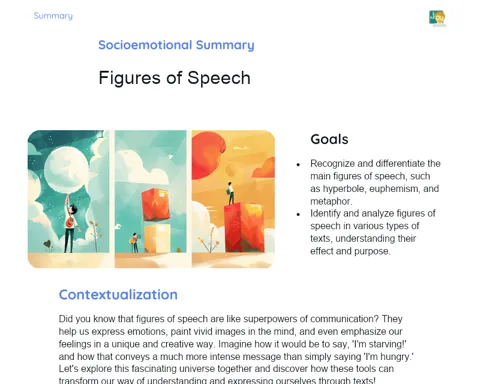Referencing | Socioemotional Summary
Objectives
1. Understand referencing as an essential element in constructing a text.
2. Recognize examples of referencing in texts and discuss their impact on textual cohesion.
3. Apply the concept of referencing in the analysis and production of texts.
Contextualization
Imagine if, during a conversation, we had to repeat the name and information about a person or thing all the time, rather than using pronouns or other forms of reference. It would be confusing and tiring, wouldn't it? Likewise, referencing in texts facilitates understanding and maintains the flow of reading, making communication more effective. 📝📚 The ability to use referencing correctly is valuable both in academic and personal and professional life, as it improves clarity and precision in communication. Let's explore together how this works! 🚀
Important Topics
Definition of Referencing
Referencing is the process by which we use pronouns, adverbs, and other linguistic elements to refer to something or someone previously mentioned in the text. This helps maintain textual cohesion and avoids unnecessary repetitions, making reading smoother and more comprehensible. 🌊📝 By using referencing correctly, the author can connect ideas cohesively, making communication clearer and more effective.
-
Maintains textual cohesion: Avoids unnecessary repetition of words, creating a more readable and pleasant text.
-
Clarity in communication: Facilitates understanding of the text, allowing the reader to follow the author's reasoning more efficiently.
-
Linguistic economy: Uses fewer words to convey the same message, increasing the effectiveness of communication.
Types of Referencing
There are two main types of referencing: anaphora and cataphora. Anaphora occurs when a term refers to something already mentioned earlier in the text, while cataphora happens when the term anticipates something that will be mentioned later. Understanding and identifying these types is essential for improving textual cohesion. 🔄📖
-
Anaphora: Refers to something previously mentioned in the text. Example: 'Maria went to the park. She loved it.'
-
Cataphora: Refers to something that will be mentioned later. Example: 'She was amazing, the person I met yesterday.'
-
Importance for cohesion: Both forms help create logical connections between different parts of the text, facilitating reading and comprehension.
Function of Referencing
The main function of referencing is to contribute to the cohesion and clarity of the text. By connecting ideas and information fluidly, referencing ensures that the reader can understand the text without difficulties. Additionally, it avoids ambiguities that could confuse the reader. 🌟🔗
-
Connection of ideas: Facilitates the establishment of relationships between different parts of the text, making reading more logical and coherent.
-
Avoid ambiguities: Uses specific terms to ensure that the reader understands exactly what or whom the author is referring to.
-
Improves the reading experience: Texts with good referencing are easier and more pleasant to read, as they avoid repetitions and confusions.
Key Terms
-
Reference: Linguistic element that points to something mentioned before or after in the text.
-
Anaphora: Reference to elements mentioned earlier in the text.
-
Cataphora: Reference to elements that will be mentioned later in the text.
-
Pronouns: Words that replace names or nouns to avoid repetitions (for example, he, she, it).
-
Adverbs: Words that modify verbs, adjectives, or other adverbs, often indicating place, time, manner (for example, here, quickly).
To Reflect
-
How can the ability to use referencing correctly improve your clarity in personal and academic communication?
-
Have you ever felt confused while reading a text with poor referencing? How did this impact your understanding of the content?
-
Think of a situation where you had to explain a complex idea. How could referencing have helped make your explanation clearer?
Important Conclusions
-
Referencing is fundamental for cohesion and clarity in texts, avoiding unnecessary repetitions and facilitating understanding.
-
There are different types of referencing, such as anaphora and cataphora, each playing a specific role in maintaining textual cohesion.
-
Mastering the use of pronouns and adverbs as elements of referencing significantly contributes to the clarity of communication, whether in academic, personal, or professional contexts.
Impact on Society
The ability to use referencing effectively in texts is crucial in today's world, where clear and efficient communication is highly valued. 📲👥 In professional environments, the ability to write and speak clearly can make a difference in presentations, reports, and even in daily email communications. In academic life, this skill is essential for producing essays and papers, ensuring a smoother and more coherent transmission of ideas.
Referencing also has a significant emotional impact. When we manage to express ourselves clearly and coherently, we avoid misunderstandings and frustrations, both for ourselves and for our interlocutors. 🌟✨ Furthermore, clarity in communication strengthens our interpersonal relationships, promoting greater understanding and empathy among people. In this way, by mastering referencing, we not only improve our linguistic skills but also contribute to a more harmonious and collaborative environment.
Dealing with Emotions
To deal with your emotions while studying referencing and its applications, use the RULER method. First, recognize any emotion that arises when facing difficulties, such as frustration or anxiety. Next, understand the causes of these emotions: they may be related to the challenge of understanding new concepts or the pressure to achieve good grades. Name these emotions correctly—such as anxiety or frustration. Then, express these emotions appropriately, perhaps by talking to a colleague or teacher about your difficulties. Finally, regulate your emotions using techniques like deep breathing or short breaks during study. 🧘🌱
Study Tips
-
Practice reading different types of texts, identifying and highlighting elements of referencing. This will help solidify your knowledge in practice and expand your understanding. 📚✏️
-
Create study cards with examples of referencing (anaphora and cataphora) and review them regularly. This will facilitate memorization and application of these concepts in your writing.
-
Join study groups and online discussions about referencing. Sharing knowledge and questions with peers can provide new perspectives and solutions to potential difficulties. 🌐👥



